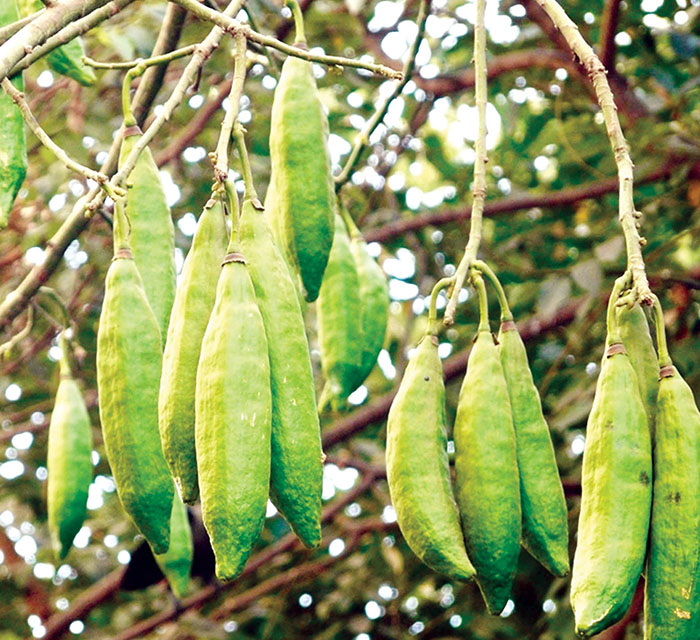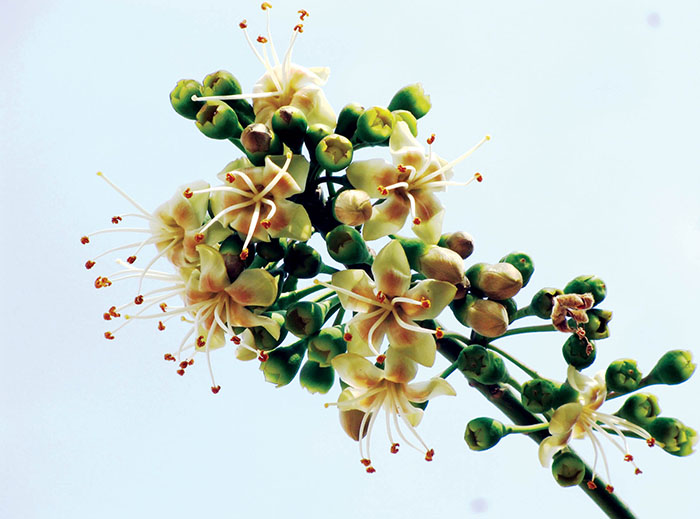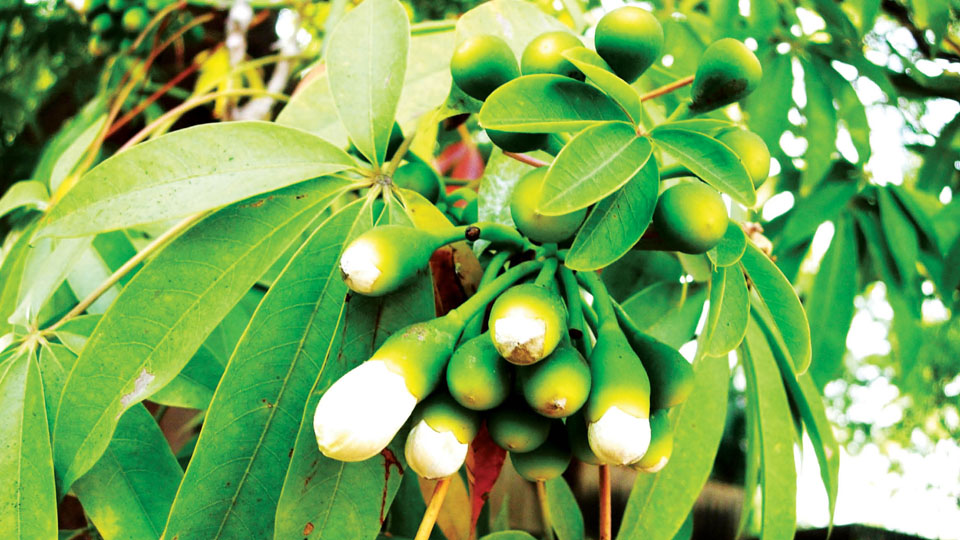Text & photographs by Dr. Mahadeswara Swamy, Scientist
Kapok’ is a fast growing majestic tree with cantilevered branches and a buttressed trunk with mature seed pods bursting out cotton-like fluff. It is found wild as well as cultivated. The tree blooms at night and emits a strong odour which attracts nocturnal pollinators. It is an exotic tree native to Mexico, Central America and the Caribbean. In the rain forests of Amazon, it is the tallest tree and host to numerous aerial plants, insects, birds, frogs and other animals. The tree is naturalised and well-distributed in hotter parts of India (South and Western India, Andaman), Burma, Sri Lanka, Malaysia and Java. The scientific name is ‘Ceiba pentandra’ belonging to the family Malvaceae (earlier placed in the family Bombacaceae). The generic name ‘Ceiba’ is an aboriginal name of Central America and specific name ‘pentandra’ refers to ‘five stamens’ in the flower.
Common names
English: The white silk cotton tree, Java Cotton, Java Kapok, Singapore Kapok, Ceiba; Kannada: Biliburuga; Hindi: Safed Semal, Kapok, Katan, Safed Savara, Shalmali; Tamil: Ilavam, Elavam, Panji; Telgu: Tellaburuga; Malayalam: Ilavu, Panjimaram, Siimappuula. The tree is the national emblem of Guatemala, Puerto Rico, and Equatorial Guinea.

Description
It is a tall massive tree possessing a broad based straight trunk with buttressed and horizontal whorled branches spreading right angles to the trunk, attaining a height of 60 ft. or more under ideal conditions; but can go up to 200 ft. with 10 ft. in diameter. Stems are prickly and greenish when young turning to brownish white with age. The trunk exudes red gum. It has pale green compound leaves with digitately divided leaflets, 5-8, with short pedicels (stalk), which are winged. Leaflets are lanceolate shaped.
The flowers are produced in axillary clusters on short stout tubercles near the end of the branches. The bulb shaped green sepals are teeth like at the end. The greenish white fleshy floral petals are twice or thrice long as the sepals; and united at the base with obtuse tips. The spindle shaped capsular fruits, overhanging from the branches in a leafless condition burst open, exposing the cotton like substance ‘floss.’ The floss is closely packed around the globular pea-like black seeds.
Three regional specific eco-varieties have been recognised — var. indica (Indian form), var. carebea (American form), var. africa (African form) based on the variations in morphology of stem, leaves, flowers, fruits and floss.
A variant of ‘Ceiba pentandra,’ which produces reddish pink flowers, is also seen. This is confused for ‘Red silk cotton tree’ or ‘Semal’ (Bombax ceiba syn. Bombax malabarica), which also produces floss. The ‘Ceiba pentandra’ can be easily distinguished from ‘Bombax ceiba’ (Semal) by the nature of the flowers. In ‘Semal,’ flowers produced in a leafless condition, are red, very conspicuous & attractive; whereas the flowers are neither conspicuous nor attractive in ‘Kapok.’ Nevertheless, the most distinguishing feature is the presence of numerous stamens in one bundle in ‘Semal.’ In addition, prickles in ‘Kapok’ are very big & persistent and the leaves fall off at the time of fruiting.

Useful tips
- The tree is cultivated for ornamental value and commercial purposes.
- It is suitable for parks and large gardens and big avenues.
- The tree can be grown in saline tracts also.
- It attracts nocturnal pollinators like bats (Indian flying fox, short nosed fruit bat etc.). Insects like bees and wasps also visit the flowers during night as well as day time.
- Pollen is allergic.
- The tree is a host for ‘Mango wood worms’ which infect the wood resulting in the death of the mango trees. Therefore, the Kapok tree should not be cultivated near mango groves.
Uses
The floss, the ‘Kapok’ of commerce, is resistant to water and decay. It is used in stuffing cushions, pillows, mattresses, dolls; in bedding and upholstery. It is also a good material for padded surgical dressings. The floss is also used in thermal insulations. A vegetable oil similar to cotton seed oil is produced. It is used as an adulterant to peanut oil in China. The oil has potential to be used as a biofuel and in paint preparation. Decoction of the bark, in its nativity, has been used as a diuretic, aphrodisiac and to treat type II diabetes besides an additive in some versions of the psychedelic drink Ayahuasca. The wood is light, soft and suitable for making canoes, toys etc.

Gardening
The trees require moist climate & well-drained soil; and survive well in elevations less than 1,500 m. The trees are generally propagated from the seeds. Pole-like large stem cuttings also root easily and can be used for growing the plants in-situ. They grow rapidly and begin to fruit within 3 to 6 years.
Where to See
Not a common tree. Seen in few places. I have noticed it on Vijayanagara 3rd Stage near Sangam Circle Main Road. The giant tree, a variant with reddish pink flowers is seen in Curzon Park, Mysuru.
Mob: 97429-91057; e-mail: [email protected]








Recent Comments